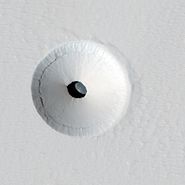
THEMIS image of probable cave entrances on Arsia Mons. The pits have been informally named (A) Dena, (B) Chloe, (C) Wendy, (D) Annie, (E) Abby (left) and Nikki, and (F) Jeanne.
The Caves of Mars Project was an early 2000s program funded through Phase II[Clarification needed] by the NASA Institute for Advanced Concepts[1][2] to assess the best place to situate the research and habitation modules that a human mission to Mars would require.[3] The final report was in mid 2004.[3]
Description[]
Caves and other underground structures, including lava tubes, canyon overhangs, and other Martian cavities would be potentially useful for manned missions, for they would provide considerable shielding from both the elements and intense solar radiation that a Mars mission would expose astronauts to. They might also offer access to minerals, gases, ices, and any subterranean life that the crew of such a mission would probably be searching for.[3]
The program also studied designs for inflatable modules and other such structures that would aid the astronauts to build a livable environment for humans and earth creatures.[3]
Summary of final report[]
Discussion of how best to seal caves to provide breathable atmosphere with air locks.[3]
Awaiting NIH approval for study of humans breathing argon.[3]
Results[]
The project showed crickets and mice could breathe argon mixtures for extended periods without apparent problems.[3]
The project produced many educational materials.[3]
Demonstrated wireless communications within limestone cave system.[3]
See also[]
- Exploration of Mars
- Colonization of Mars
References[]
- ↑ Template:Cite book
- ↑ David, LeonardS (2005-02-22). "Digging and Sniffing for Life on Mars". Space.com. http://space.com/scienceastronomy/050222_mars_methane.html. Retrieved 2010-06-30.
- ↑ 3.0 3.1 3.2 3.3 3.4 3.5 3.6 3.7 3.8 Boston, P.; Frederick, G.; Frederick, G.; Welch, S.; Werker, J.; Meyer, T.R.; Sprungman, B.; Hildreth-Werker, V. et al. (2004). "System Feasibility Demonstrations of Caves and Subsurface Constructed for Mars Habitation and Scientific Exploration". NASA Institute for Advanced Concepts. http://www.niac.usra.edu/files/studies/final_report/710Boston.pdf. Retrieved 2010-06-30.
External links[]
- The Caves of Mars Project
- Human utilization of subsurface extraterrestrial environments (2002 NIAC Paper on living underground on Mars)
News
- Gallegos, Emma (2009-10-21). "Astrogeologists discover shallow caves that could provide shelter for life on Mars". Pasadena Star-News online. http://www.pasadenastarnews.com/ci_13611947. Retrieved 2009-10-25.
- Herbert W. Franke, "Höhlen auf dem Mars", Naturwissenschaftliche Rundschau 1998, Issue 5, page 169-175
- "Life in the Extremes: An Interview With Dr. Penelope Boston", 2000
- Radio interview on the caves with NASA scientists by Planetary Society.
Template:Manned mission to Mars
| This page uses Creative Commons Licensed content from Wikipedia (view authors). | 
|


